Video of the Week:
Tomato Problems
Fruit:
Bacterial Spot of Peach
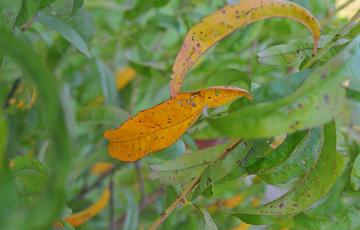
Fruit infections are mostly superficial but more serious infections can cause pitting and cracking of the fruit surface.
Peach cultivars vary in their susceptibility to bacterial spot, although no variety is immune. Those cultivars showing tolerance to the disease include Belle of Georgia, Biscoe, Candor, Comanche, Dixired, Earliglo, Early-Free Red, Emery, Encore, Garnet Beauty, Harbelle, Harbinger, Harbrite, Harken, Late Sunhaven, Loring, Madison, Norman, Ranger, Redhaven, Redkist, Redskin, Sentinel, and Sunhaven.
Cultivars most susceptible to bacterial spot are Autumnglo, Autumn Lady, Blake, Elberta, Halehaven, July Elberta, Jersey Queen, Jerseyland, Kalhaven, Suncling, Suncrest, Sunhigh, Ran Cocas, Redcrest, Rio-Oso-Gem, and Sweet Sue. Most apricot and nectarine cultivars are susceptible to bacterial spot.
Excessive fertilization can predispose peaches to severe bacterial spot infections. On the other hand, proper fertilization is necessary to maintain tree vigor and to prevent the development of Cytospora canker. Monitoring the fertility needs of trees is best accomplished through soil and leaf analysis.
Since this disease is cause by a bacteria, fungicides found in fruit tree sprays are ineffective. (Ward Upham)
Vegetables:
Tomato Leaf-Spot Diseases
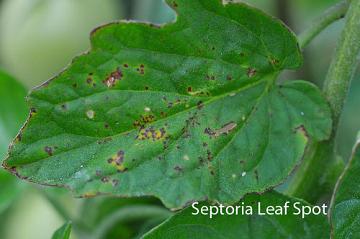
Septoria leaf spot usually appears earlier in the season than early blight and produces small dark spots. Spots made by early blight are much larger and often have a distorted “target” pattern of concentric circles. Heavily infected leaves eventually turn yellow and drop. Older leaves are more susceptible than younger ones, so these diseases often start at the bottom of the plant and work up.
Mulching, caging, or staking keeps plants off the ground, making them less vulnerable. Better air circulation allows foliage to dry quicker than in plants allowed to sprawl. Mulching also helps prevent water from splashing and carrying disease spores to the plant.
In situations where these diseases have been a problem in the past, rotation is a good strategy. It is too late for that now, but keep it in mind for next year. Actually, rotation is a good idea even if you have not had problems in the past. But many gardens are too small to make it practical. If you have room, rotate the location of the tomatoes each year to an area that has not had tomatoes or related crops (peppers, potatoes, eggplant) for several years.
If rotation is not feasible, fungicides are often helpful. Be sure to cover both upper and lower leaf surfaces, and reapply fungicide if rainfall removes it. Plants usually become susceptible when the tomato fruit is about the size of a walnut. Chlorothalonil is a good choice for fruiting plants because it has a 0-day waiting period, meaning that fruit can be harvested once the spray is dry. Chlorothalonil can be found in numerous products including Fertilome Broad-Spectrum Landscape and Garden Fungicide, Ortho Garden Disease Control, GardenTech Daconil and others. Be sure to start protecting plants when the disease is first seen. It is virtually impossible to control this disease on heavily infected plants.
If chlorothalonil doesn’t seem to be effective, try mancozeb (Bonide Mancozeb Flowable). Note that there is a five-day waiting period between application and when the fruit can be harvested. You may wish to pick some tomatoes green just before you spray if you use Mancozeb as the tomato fruit will ripen inside. (Ward Upham)
"Tomatoes" on Potatoes
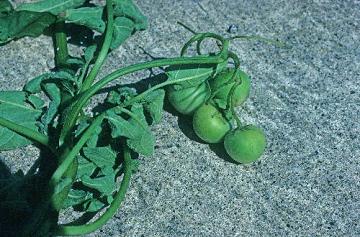
Flowers:
Rose Rosette
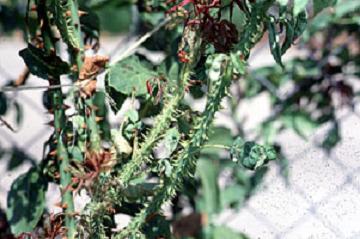
Infection is thought to start with rapid elongation of a new shoot. The rapid shoot growth may continue for several weeks to a length of two to three feet. Following shoot elongation, a witches' broom or clustering of small branches occurs. The stems develop excessive thorniness and produce small, deformed leaves with a reddish-purple pigmentation. Stems and petioles of Rosa multiflora plants may have reddish blotches or streaks. Rose plants infected with the rose rosette virus die rapidly, usually within one to two years.
Rose rosette is caused by an aster yellows phytoplasma. Transmission of the disease has been shown experimentally through grafting and through an eriophyid mite, Phyllocoptes frutiphilus. Though KnockOut roses are resistant to many diseases, they are susceptible to this one.
There is no effective control measure for infected plants. In garden settings, infected plants should be removed and destroyed, including roots. Any roots that remain after plant removal may produce infected shoots which can harbor the disease.
If possible, eliminate all multiflora rose plants from the vicinity as they are extremely susceptible and will act as a carrier. Multiflora rose is the wild rose often seen growing in ditches and pastures.
Since the disease can be transmitted by pruning shears, disinfect the shears when moving from one plant to another by using rubbing alcohol or a disinfectant such as Lysol. (Ward Upham)
Pests:
Borer Control in Peaches

Sprays should be applied the last week in June and again the last week in July for good control. Thoroughly cover the bottom portion of the trunk to the point that some spray pools at the base of the tree. Peach tree borers lay eggs on the tree trunk. When the larva hatches, it tunnels through the bark into the tree. If an insecticide is present on the trunk, the larva is killed when it tries to tunnel.
Most of the active ingredients that were labeled for peach tree borer and lesser peach tree borer in homeowner packaging are now gone, except for permethrin, which is found in numerous products. Those that have peach tree borer on the label include Hi-Yield Garden, Pet and Livestock Insect Control, Hi-Yield 38, Bonide Borer-Miner Killer and Gordon’s Bug-No-More Yard and Garden Insect Spray. (Ward Upham)
Squash Bugs
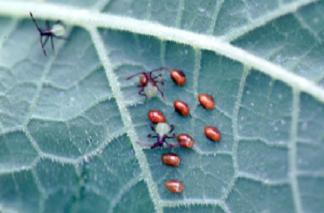
Because squash bugs feed by sucking juice from the plant, only insecticides that directly contact the insect will work. General use insecticides such as permethrin (Bug-B-Gon Multi-Purpose Garden Dust, Green Thumb Multipurpose Garden and Pet Dust, Bug-No-More Yard and Garden Insect Spray, Eight Vegetable, Fruit and Flower Concentrate, Garden, Pet and Livestock Insect Control, Lawn & Garden Insect Killer), malathion, and methoxychlor provide control if a direct application is made to young, soft-bodied squash bugs. This means that you MUST spray or dust the underside of the leaves because this is where the insects live. (Ward Upham)
Elm Flea Weevil
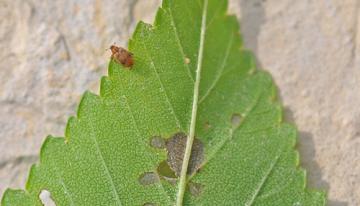
The adult of this insect is a very small (1/8 inch) brown weevil with dark spots on the back. It sports a short, curved snout and has the ability to hop.
Eggs from overwintering adults hatch on newly formed leaves. The larva produces a serpentine pattern in the leaf that terminates on a leaf edge. Adults have emerged now and are feeding on the leaves. Adult feeding damage produces a shothole pattern in the leaves. Heavily fed upon leaves appear lacy. There is one generation per year and so when the adults disappear, there should be no further damage this year.
I have not seen any control strategies for this insect. Trees typically recover from spring defoliations. (Ward Upham)
Contributors: Ward Upham, Extension Associate
 RSS Feed
RSS Feed
